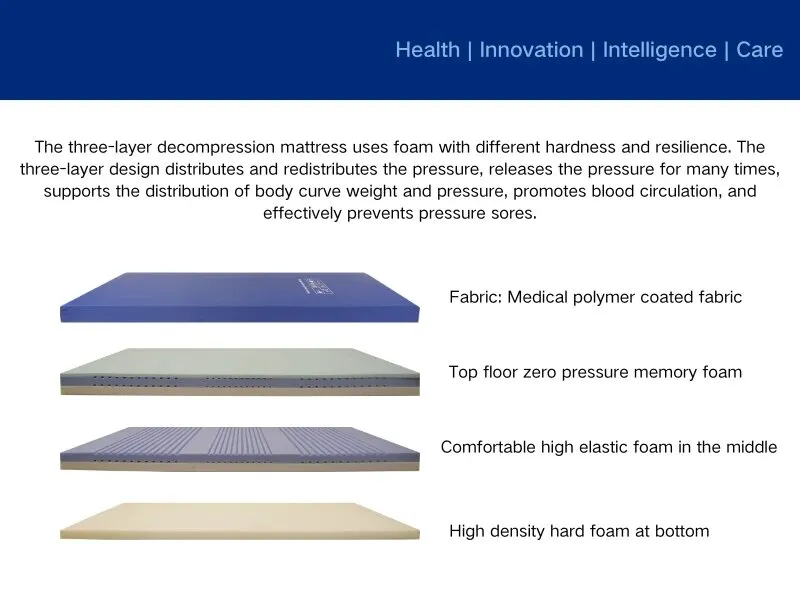Comparing Wave Mattress and Air Mattress: Which Is Better for Medical Use?
In healthcare settings, choosing the right support surface can significantly impact patient outcomes, particularly for those at risk of pressure injuries or requiring extended bed rest. Two prominent technologies have emerged in medical mattress design: the innovative wave mattress and traditional air mattress systems. The wave hybrid mattress represents an evolution in pressure redistribution technology, combining wave-like support structures with advanced materials, while air mattresses rely on adjustable air chambers for customizable support. This comprehensive comparison examines how these technologies perform in clinical environments, analyzing their respective benefits for wound prevention, patient comfort, and caregiver functionality.

Pressure Redistribution Capabilities: Wave Mattress vs. Air Chambers
The fundamental purpose of medical mattresses lies in their ability to redistribute pressure away from vulnerable bony prominences. The wave foam mattress achieves this through its unique undulating surface design that creates multiple points of contact with the patient's body. This three-dimensional structure allows for even weight distribution while maintaining proper spinal alignment - a critical factor for patients with limited mobility. Clinical studies have shown that the wave pattern can reduce interface pressures by up to 30% compared to flat surfaces, making it particularly effective for preventing pressure ulcers in high-risk patients.
Air mattresses, including the air wave mattress variants that incorporate some wave-like features, use a different approach to pressure management. These systems contain interconnected air cells that alternately inflate and deflate in specific patterns, constantly shifting pressure points. While effective for some patients, air mattresses may not provide the consistent support of wave technology, particularly for bariatric patients or those with contractures. The dynamic nature of air mattresses can sometimes cause discomfort for patients who prefer stable sleeping surfaces, whereas the wave hybrid mattress offers a compromise between static support and dynamic pressure redistribution.
Wave Mattress: Microclimate Management and Temperature Regulation
Patient comfort and skin health depend heavily on proper microclimate management - the control of heat and moisture at the skin-mattress interface. The wave foam mattress design naturally promotes airflow through its contoured channels, allowing heat to dissipate and moisture to evaporate more efficiently than flat surfaces. This breathability is crucial for preventing moisture-associated skin damage, a common precursor to pressure injuries. Many modern wave mattresses incorporate phase-change materials or gel-infused foams that actively regulate temperature, providing additional benefits for patients prone to overheating.
Traditional air mattresses address microclimate differently, relying on the open space between air cells for ventilation. However, the air wave mattress models that combine wave-like surfaces with air technology show improved performance in this regard. The challenge with pure air systems lies in their tendency to retain heat when fully inflated, potentially creating a less optimal environment for skin integrity. Some premium wave hybrid mattress designs now outperform air mattresses in clinical tests measuring skin temperature and humidity levels over extended periods.
Wave Mattress: Clinical Versatility and Patient-Specific Adaptability
Medical facilities require mattresses that can adapt to diverse patient needs and changing clinical conditions. The the wave hybrid mattress demonstrates particular strength in this area, offering customizable firmness levels through its combination of wave-structured support layers and adjustable base materials. This adaptability allows healthcare providers to tailor the surface to individual patient requirements without the mechanical complexity of air systems. For patients with existing pressure injuries, the consistent support of wave technology often proves more comfortable than the shifting surface of alternating air mattresses.
Air mattresses traditionally held an advantage in weight capacity and adjustability, but modern wave hybrid mattress designs have closed this gap significantly. Advanced wave mattresses now accommodate patients up to 500 pounds while maintaining their pressure-redistribution properties. The simplicity of wave systems also reduces maintenance requirements compared to air mattresses, which need regular checks for leaks and proper pump function. In long-term care settings where reliability is paramount, the durability of wave foam mattress constructions often makes them the preferred choice.
Wave Mattress: Infection Control and Maintenance Considerations
Healthcare-associated infections remain a critical concern in medical facilities, making mattress hygiene a crucial selection factor. The wave foam mattress design offers distinct advantages in this regard, as most models feature seamless, fluid-impermeable covers that are easily disinfected. The solid construction eliminates crevices where pathogens could accumulate - a common issue with air mattresses that have multiple seams and connection points. Many wave mattresses are constructed with antimicrobial materials that actively inhibit bacterial growth, providing an additional layer of protection.
Air mattresses present more challenges for infection control due to their complex structure of interconnected air chambers. While the air wave mattress models have improved in this aspect with better-sealed designs, they still require more intensive cleaning protocols between patients. The mechanical components of air systems (pumps, hoses, and valves) also represent potential contamination points that don't exist with non-powered wave hybrid mattress options. For isolation rooms or high-risk infection environments, the simplicity and cleanability of wave technology often make it the safer choice.
Wave Mattress: Cost-Effectiveness and Long-Term Value Analysis
When evaluating mattress systems for medical use, healthcare administrators must consider both initial investment and total cost of ownership. The wave foam mattress typically requires lower upfront costs compared to sophisticated air mattress systems, and more importantly, incurs significantly fewer maintenance expenses over time. Without pumps, air chambers, or electronic components to repair or replace, wave mattresses demonstrate remarkable durability in busy clinical environments. Many hospitals report service lives of 5-7 years for quality wave mattresses versus 3-5 years for air mattresses under similar conditions.
The the wave hybrid mattress represents a middle ground in terms of cost, offering some of the advanced features of air systems without their mechanical complexity. While hybrid models carry higher initial costs than basic wave mattresses, they often prove more cost-effective than full air systems when factoring in reduced energy consumption (no continuous power requirement) and lower replacement part needs. For budget-conscious healthcare providers looking to maximize value without compromising patient outcomes, wave technology frequently emerges as the most financially sustainable option.
Wave Mattress: Determining the Optimal Choice for Medical Applications
After examining all critical factors, the wave mattress system generally proves superior to traditional air mattresses for most medical applications. Its combination of excellent pressure redistribution, superior microclimate management, easier infection control, and lower total cost of ownership makes it the preferred choice for hospitals, long-term care facilities, and home care environments. The evolution of wave hybrid mattress technology has further bridged any remaining gaps in adjustability and weight capacity, making these systems appropriate for nearly all patient populations.
That said, air wave mattress solutions still have their place in specific clinical scenarios, particularly for patients who respond better to dynamic pressure redistribution or require frequent position changes. However, for routine prevention of pressure injuries and general patient comfort, the wave foam mattress offers more consistent performance with fewer operational challenges. As healthcare continues to emphasize evidence-based practices and cost-effective solutions, wave technology stands out as the more reliable and sustainable option for most medical mattress needs. Facilities investing in the wave hybrid mattress systems often find they achieve better patient outcomes while simplifying clinical operations and reducing long-term expenses.
-
The Truth About "Orthopedic" Mattresses for Sore Back PainNuachtAug.23,2025
-
Space-saving Benefits of a Single Mattress CubeNuachtAug.23,2025
-
Eco-friendly Advantages of a Silicon MattressNuachtAug.23,2025
-
How to Fix Sagging in a Special MattressNuachtAug.23,2025
-
How Ambulance Stretcher Mattresses Reduce Pressure InjuriesNuachtAug.23,2025
-
Best Cleaning Practices for a Hospital Mattress DoubleNuachtAug.22,2025
-
Mattresses Designed for Back Pain ReliefNuachtAug.08,2025

